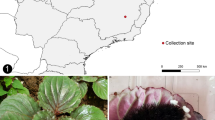Abstract
Amplified fragment length polymorphism (AFLP) is a powerful DNA fingerprinting technique for studying genetic relationships and genetic diversity in insects. However, the crucial prerequisite for AFLP analysis is to extract DNA of high quality. In this study, we evaluate four different protocols (SDS method, improved SDS method, CTAB method and a complex method with SDS and CTAB) for isolating DNA from the seabuckthorn carpenter moth (Holcocerrus hippophaecolus (Lepidoptera: Cossidae)). The results indicate that the CTAB method does not produce DNA suitable for AFLP analysis. The SDS method and the complex method with SDS and CTAB are comparatively time-consuming and resulted in low yields of DNA and were therefore not used for AFLP assay. The improved SDS method is recommended for preparing DNA templates from H. hippophaecolus for AFLP analysis.
Similar content being viewed by others
References
David J H. 2001. AFLP-based genetic linkage map of the colorado potato beetle Leptinotarsa decemlineata: Sex chromosomes and a pyrethroid-resistance. Candidate Gene Genet, 158: 695–700
Del S G, Manfioletti G, Schneider C. 1989. The CTAB DNA precipitation method: a common mini-scale preparation of template DNA from phagemids, phages or plasmids suitable for sequencing. BioTechniques, 7: 514–520
Forneck A, Walker M A, Blaich R. 2000. Genetic structure of an introduced pest: grape phylloxera (Daktulosphaira vitofoliae Fitch) in Europe. Genome, 43: 669–678
Garcia J, Maekaw A K, Miura T. 2002. Population structure and genetic diversity in insular populations of Nasutitermes takasagoensis (Isoptera: termitidae). Zool Sci, 19: 1141–1146
Gustincich S G. Manfioletti G, Del S G, Schnider C, Carninci P. 1991. A fast method for high quality genomic DNA extraction from whole human blood. Biotechniques, 11: 298–302
Harrison R G, Rand D M, Wheeler W C. 1987. Mitochondrial DNA variation in field crickets across a narrow hybrid zone. Mol Biol Evol, 4: 144–158
Lin J J, Kuo J. 1995. AFLP: a novel PCR-based assay for plant and bacterial DNA fingerprinting. Focus, 17: 52–56
McMichael M, Prowell D P. 1999. Differences in amplified fragment length polymorphisms in fall army worm (Lepidoptera: Noctudiae) host strains. Ann Entomol Soc Amer, 92: 175–181
Meunier J R, Grimont P A D. 1993. Factors affecting reproducibility of random amplified polymorphic DNA fingerprinting. Res Microbiol, 144: 373–379
Moeller E M, Bahnweg G, Sandermann H, Geiger H H. 1992. A simple and efficient protocol for isolation of high molecular weight DNA from filamentous fungi, fruit bodies, and infected plant tissues. Nucleic Acids Res, 22: 6115–6116
Muralidharan K, Wakeland E K. 1993. Concentration of primer and template qualitatively affects products in random amplified polymorphic DNA PCR. BioTechniques, 14: 362–364
Tixier M H, Sourdille R M, Leroy P. 1997. Detection of wheat microsatellites using a non radioactive silver-nitrate staining method. J Genet Breed, 51: 175–177
Vos P, Hogers R, Bleeker M, Reijans M, Van de Lee T, Hornes M, Frijters A, Pot J, Peleman J, Kuiper M, Zebeau M. 1995. AFLP: a new technique for DNA fingerprinting. Nucleic Acids Res, 23: 4407–4414
Wu Y Q, Huang Y H, Tauer C G, Porter D R. 2006. Genetic diversity of sorghum accessions resistant to green bugs as assessed with AFLP Markers. Genome, 49: 143–149
Zhang D Q, Zhang Z Y, Yang K, Tian L. 2002. Segregation of AFLP markers in a (Populus tomentosa × P. bolleana) × P. tomentosa Carr. BC1 family. For Stud China, 4: 21–26
Zhang D X, Hewitt G M. 1998. Isolation of animal cellular total DNA. In: Karp A, Isaac P G, Ingram D S (eds.). Molecular Tools for Screening Biodiversity: Plants and Animals. London: Chapman & Hall, 5–9
Zong S X, Luo Y Q, Xu Z C, Wang T, Zong Y F. 2006. Problems in seabuckthorn carpenter moth: Holcocerus hippopaecolus (Lepidoptera: Cossidae) studies. For Pest Dis, 25:29–32 (in Chinese with English abstract)
Author information
Authors and Affiliations
Corresponding author
Rights and permissions
About this article
Cite this article
Chen, M., Zhu, Yy., Tao, J. et al. Methodological comparison of DNA extraction from Holcocerrus hippophaecolus (Lepidoptera: Cossidae) for AFLP analysis. For. Stud. China 10, 189–192 (2008). https://doi.org/10.1007/s11632-008-0035-5
Received:
Accepted:
Published:
Issue Date:
DOI: https://doi.org/10.1007/s11632-008-0035-5




